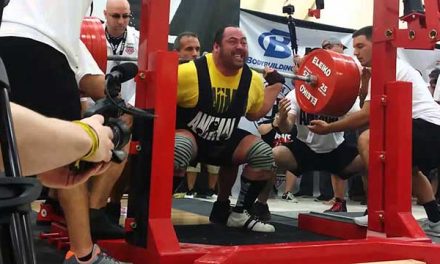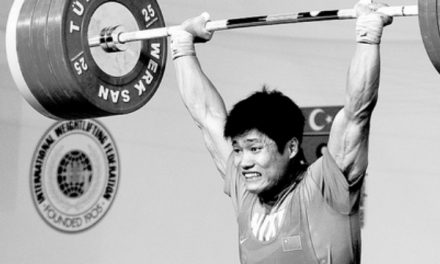By: Chris Munoz, MS, CSCS
People who lift weights or are really into fitness often get made fun of by the general public. People sometimes find “health nuts” to be obnoxious, arrogant, and unapproachable. Truthfully, there are people out there who give the rest of us a bad reputation, but there is a reason that health is so important to the population in question, even if they aren’t completely aware of it: Your reproduction chances depend on your fitness. In this article series, we’re going to be discussing natural selection, sexual competition, and the role physical fitness plays in reproduction. By the end of this, you should have a better understanding of why physical fitness is so important, aside from the whole keeping-yourself-alive-and-disease-free component, and how what role it plays in your sexual motivations and behaviors.
Darwinian Fitness
If you’ve taken 9th grade biology then you’ve probably heard of Charles Darwin and his theory of evolution and the idea of “natural selection.” For those of you who skipped that day of class, Charles Darwin was a naturalist who intensely studied life on this planet and did the first in the field of genetics, even if it wasn’t called “genetics” at the time. The following is an excerpt from his seminal work “On the Origin of the Species” (1859):
I think it would be a most extraordinary fact if no variation ever had occurred useful to each being’s own welfare, in the same way as so many variations have occurred useful to man. But, if variations useful to any organic being do occur, assuredly individuals thus characterized will have the best chance of being preserved in the struggle for life; and from the strong principle of inheritance they will tend to produce offspring similarly characterized. This principle of preservation, I have called, for the sake of brevity, Natural Selection.
Now, I understand that there are a lot of words in there that may be foreign to modern day English speakers, such as “thus” and “brevity” and “the”, but try to stay with me here. Essentially, the primary drive of any species is to preserve their genetic information by passing it on to offspring who will thrive and so, those who possess characteristics that give them an advantage in this life will be able to reproduce more often and those offspring will carry on those advantageous traits. By now, you’re probably asking what any of this has to do with physical fitness. The short answer is: everything. The shorter answer is: mating. The shortest answer is: sex.
The male mind is basically hardwired for quantity when it comes to choosing sexual partners; the strategy is to fire your gun then “reload and get back out there” (Ogas & Gaddam, 2011). Needless to say, men think about sex quite often; it’s not every 10 seconds or something ridiculous like that, but we do think about it ad nauseum. Think of it this way, what is the cost for a male to reproduce? On a good day, something like five minutes. If you’re in a hurry, or a beginner, or really bad in bed, then it’s more like 10 seconds. Either way, it’s not a whole lot. After the refractory period (the amount of time males need to “reload”) males can literally move on to another woman and try their best to impregnate her as well. For males, it is in their best interest to try and impregnate as many females as possible to improve their statistical chances of having strong, viable offspring to carry on their genetic lineage. Keep in mind, this is a strategy that evolved over thousands of years and contemporary society does have some say in how we go about things these days. That being said, let’s move on to the fairer sex, females.
When it comes to the topic of sexual motivation, the female brain couldn’t be more different from their male counterparts. Again, dear reader, I ask you, what is the cost for a female to reproduce? You might say nine months, but you would be forgetting that we are mammals and mammals have to raise their young. So while it is nine months of gestation, you have to add on another 18 years or so. Therefore, time is certainly a big cost in the business of reproducing. How about resources? Not only does the female body require more calories while pregnant and breastfeeding, but eventually their offspring will need to eat as well. Shelter, clothing, protection, these are all required in addition to time and food to successfully reproduce and raise a child. (Trivers, 1972). On top of all that, pregnancy makes females less ambulatory and more vulnerable to things like violence and predation, though, admittedly, not many humans are being regularly hunted by lions or bears these days. Basically, the cost of reproduction is exponentially greater for a female and so, they must be extremely careful when it comes to choosing a mate. Due to this, we consider the female brain to be wired to seek out quality mates, as opposed to a large quantity of mates, because it is in the best interest for the female to pick a good, viable mate who can provide her with healthy and strong offspring as well as the essentials to raise them (Symons, 1979).
This is not exclusive to humans; not by any means. Our primate relatives have been observed doing the exact same thing. While not ovulating, female primates have been known to mate with lesser males because they know they will not get pregnant. They figure that some protection is better than none, and so they associate with mid-level males in their troop. However, when they are ovulating, that same female will only mate with the alpha male. Why? The alpha has the best genes, the most resources, and the most power. The female knows that her children will bear the dominant traits of their father (there’s natural selection again) and that her children will never go hungry because daddy will always be able to provide for them. (Buss, 1994). Furthermore, she knows that her children, and her by association, are going to be safe because no other male in the troop is going to go up against the alpha. Psychologists have observed similar behaviors in human females. Apparently, when human females are not ovulating, they are far more likely to go home with a random guy. When they are ovulating, human females will actually dress more provocatively, their breasts will enlarge slightly, and they will be more flirtatious. Furthermore, they will only go home with a male that they deem to be sufficiently dominant. I should probably mention that they are not aware this is happening; all of their behavior and evaluating is happening without their conscious mind knowing about it.
Physical Attraction and Desire
Now, the million dollar question, or questions, I guess: What is considered to be a dominant characteristic in males? What reproductive signals do females give off to gain the attention of desirable males? Let’s start with the ladies. During puberty, and particularly once females begin to engage in sex, the hips of women begin to widen. This is because your body thinks you are getting ready to reproduce. In addition, adipose tissue will start to accumulate in certain areas like the breasts and buttocks. Adipose tissue comes from excess calories and is only stored in those areas when the female is biologically mature, so it’s no surprise then that most males have an obsession with those body parts, even if they don’t know why. Basically, the female body is screaming “I’m fertile and I’m ready”, which is why they are the qualifying visual cues for reproduction (Ogas & Gaddam, 2011). Along with those areas, males are going to be more attracted to healthy looking females, because healthy mate equals healthy child. Stronger, healthier women are going to attract more desirable males independent of their facial attractiveness. In this respect, males are not that different.
While teaching this in my class, I’ll often ask my female students if any of them would like to volunteer some information. I ask them, “When you are looking for a boyfriend, a long-term boyfriend, what qualities are you looking for?” Inevitably, the same adjectives always come up: strong, intelligent, caring, protective, etc. If you look closely at those answers, there is a pattern there that we can easily apply to what we have just learned. Strength and protection are basically ways to say that females are looking for a strong male who will be able to protect them from other males and take care of them in dangerous situations. That is not to say that females cannot take care of themselves; nothing is further from the truth. In fact, one of the benefits of choosing a strong and fit woman is that they are less reliant on male protection and assistance. However, it is a basic biological instinct that needs to be satisfied because during pregnancy the female is vulnerable. Males are supposed to be bigger and stronger; this is why they require less essential body fat and put on more muscle, even though fiber for fiber, females are just as strong.
When training, it is important to keep in mind why you are doing it. At the end of the day, training bestows a multitude of benefits to the human body and improves your physical fitness. From an evolutionary standpoint though, training is also improving your Darwinian fitness. By increasing strength, adding muscle, elevating your endurance levels, lowering your resting heart rate, etc., you are ensuring you own physical vitality and maximizing your physical traits. By doing this, regardless of sex, you are making yourself more desirable to the opposite sex on an instinctual level. Think of it this way, gentlemen, muscles and, more importantly, health, give you an advantage over rival males. Ladies, the healthier and more physically fit woman will most likely attract the male she wants (Buss, 1994). Vying for a sexual partner is a competition, specifically “intraspecific competition”, but let’s not get into that just yet. Quite simply, physical fitness correlates to your fitness as a mate for reproduction.
Obviously, this is only a theory from the school of evolutionary psychology. Human sexuality is incredibly complex and I would be quite naïve and arrogant to think that I could explain it in a measly article. There are still studies being conducted to see where homosexuality fits into this, if at all, and not everyone is attracted to physically fit individuals. On top of all that, this theory fails to address sexual fetishes and recreational sex. However, it does seem as though this theory is on to something. When nature selects the next generation of organisms on this planet, human or otherwise, it is going to be the bigger, stronger, healthier, and smarter individuals who are going to be the ones passing on their genes at a rate significantly higher than lesser mates. So, if I were to offer you a lethargic, overweight drug addict or an educated athlete to reproduce with, who would you choose?
Peacocking
Let’s conduct a social experiment. I would like you, dear reader, to walk into any traditional gym, such as LA Fitness or Bally’s. Once you walk in, walk over to the aerobics area and have a seat on one of those comfy recumbent bikes (the type with the back that you can lean back on) cause we’re going to be here for a while. Now, normally, the aerobics area is positioned in a way that allows the average gym-goer a good view of the free-weights and machines area. This is not an accident. So, now that you’ve got a good vantage point, I want you to observe the people in the weights area for at least twenty minutes or so. I would also like you to try and refrain from laughing or you may disturb the animals and interrupt their mating ritual.
What’s up with that guy wearing three layers of Under Armour? How about that other dude grunting loudly (read: annoyingly) with every rep of his bicep curls? Oh! Look at that other dude! He doesn’t even have a shirt on at this point! Did you notice the woman with the ridiculously short shorts at the cable machine with her butt, excuse me, I mean hips pushed all the way out? At least she’s not as bad as her friend, who is just walking around in a sports bra while texting on her phone; she’s not even trying to pretend she’s exercising. What do all these individuals have in common, or rather, what behavior are they engaging in? Peacocking.
The true term is closer to what we mentioned before, intraspecific competition (Christian, 1970). Peacocks have a beautiful set of hind feathers that serves a couple of uses, but one of the primary ones is to get them noticed by prospective mates. Bucks have giant antlers that they display to attract mates, and will engage other males with them to win the heart of a doe. Some people, much like the late Ronald Fisher, a biologist in the 1930’s, believe traits such has hair color are just random accidents and are no more advantageous over others for sexual competition (Inglis-Arkell, 2012). This would explain why some people prefer blondes, some redheads, etc. and there’s no discernible difference in reproduction rates between particular hair colors. For the most part though, scientists tend to agree that there must be a rhyme and reason to the way we select mates, and nothing is more powerful than effective advertising.
Traditional gyms know this, and this is why most aerobic areas have a great view of the “peacocks” with their feathers on full display, so to speak. They do this to increase motivation on an instinctual level. Motivation improves performance and program adherence. Next thing you know, you start losing weight on the treadmill, you associate the success with the gym, and all of a sudden you can’t stop praising your gym. You’ve become an LA Fitness walking advertisement; it’s a really clever marketing tactic. So, the next time you encounter an irritating/narcissistic gym rat, just remember they’re just trying to attract a mate, and it might be you.
Chris Munoz is a professor, strongman competitor and former collegiate Rugby player. He has a Master’s in Sports Psychology with plans on obtaining his ph.D in the field. He’s also a National Strength & Conditioning Association Certified Strength & Conditioning Specialist (CSCS) and a fan of soccer and The Black Keys.
Stay connected!
Here’s how to follow us:
Instagram: @GentlemanAndMeathead
Facebook: Facebook.com/GentlemanAndMeathead
Twitter: @ClassyMeathead
References:
Buss, D. M. (1994). The evolution of desire: Strategies of human mating. Basic books.
Darwin, Charles. On the Origin of Species, 1859. Washington Square, NY: New York UP, 1988. Print.
Ogas, O. (2011). A Billion Wicked Thoughts: What The World’s Largest Experiment Reveals About Human Desire Author: Ogi Ogas, Sai Gaddam, Pu.
Symons, Donald. The Evolution of Human Sexuality. New York: Oxford UP, 1979. Print.
Trivers, R. (1972). Parental investment and sexual selection.












Trackbacks/Pingbacks